Melling is a suburb of Lower Hutt, to the north of Wellington in the North Island of New Zealand. It is on the west bank of the Hutt River, on State Highway 2, the Wellington-Hutt main road, and directly across the river from the centre of Lower Hutt. It is also the name of the three-lane bridge connecting the Hutt City central business district with State Highway 2, a route subject to extensive congestion at peak times. From the Melling Bridge it is possible to drive straight ahead into the hill suburbs of Harbour View and Tirohanga.
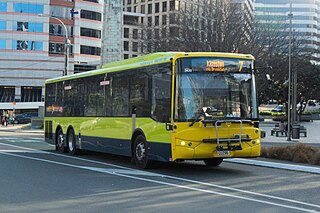
The Wellington Region has a well developed public transport system, the most used in New Zealand. It consists of electric and diesel buses, commuter trains, ferries and a funicular. It also included trams until 1964 and trolleybuses until 2017.

The Wairarapa Line is a secondary railway line in the south-east of the North Island of New Zealand. The line runs for 172 kilometres (107 mi), connects the capital city Wellington with the Palmerston North - Gisborne Line at Woodville, via Lower Hutt, Upper Hutt and Masterton.
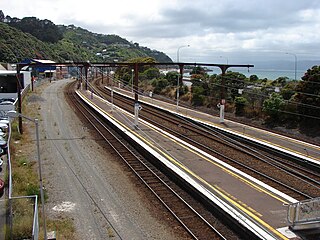
Kaiwharawhara railway station, a former railway station on the North Island Main Trunk and the Wairarapa Line in Wellington in New Zealand, closed in 2013. It was the first station north of Wellington, serving the early suburb of Kaiwharawhara. Prior to its closure it was served by trains operated by Tranz Metro as part of the Metlink network on the Melling Line, the Hutt Valley Line and the Kapiti Line.

Petone railway station is a dual platform, suburban railway station located in the Lower Hutt, New Zealand suburb of Petone. It is on the Hutt Valley section of the Wairarapa Line, 10.5 km (6.5 mi) north of Wellington, and is the junction for the Melling Branch to Melling, which diverges westward from the main line to the north of the station. The station is served by Metlink suburban services, operated by Transdev Wellington, to Wellington, Melling, Taita, Upper Hutt and Masterton.

Ngauranga railway station is a single island platform railway station in the mainly industrial and commercial suburb of Ngauranga on the Wairarapa Line in Wellington, New Zealand. It is on the Wellington suburban rail network and is served by Melling Line trains and some only Hutt Valley Line trains. Wairarapa Connection trains pass this station but do not stop. All trains are run by Transdev as part of the Metlink network.

The Hutt Valley Line is the electrified train service operated by Transdev Wellington on behalf of Metlink on the section of the Wairarapa Line railway between Wellington and Upper Hutt, New Zealand.

Upper Hutt railway station is a suburban railway station serving central Upper Hutt, New Zealand. The station is on the Wairarapa Line, 32.4 km (20.1 mi) north of Wellington, and is served by Transdev Wellington on behalf of the Greater Wellington Regional Council. The station is the northern terminus for the electrified Hutt Valley Line to and from Wellington. The diesel-hauled Wairarapa Connection stops at Upper Hutt on its route between Wellington and Masterton.

Waterloo railway station is a dual-platform suburban railway station located in Lower Hutt, New Zealand, and serving immediately the suburbs of Waterloo, Lower Hutt Central and Woburn. The station stands on the Hutt Valley section of the Wairarapa Line, 15.5 km (9.6 mi) north of Wellington. Trains stopping at Waterloo run to Wellington, Taita, Upper Hutt and Masterton, as well as to points in between. Waterloo serves as a major bus-rail interchange, connecting buses to and from central Lower Hutt, Naenae and Wainuiomata with trains to and from Wellington.
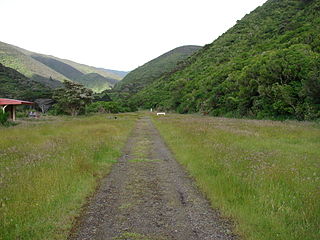
Cross Creek railway station was the base of operations for the Rimutaka Incline, a Fell railway over the Remutaka Ranges, and part of the original Wairarapa Line between Upper Hutt and Featherston in the Wellington region of New Zealand's North Island. The station was between Pigeon Bush and Summit stations on the Wairarapa Line. The station was bypassed when the Rimutaka Tunnel was opened.
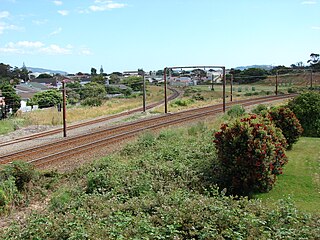
The Gracefield Branch is a 1.6 km long, 3 ft 6 in gauge industrial line from its junction with the Wairarapa Line at Woburn in the Wellington region of New Zealand's North Island to its terminus at the southern end of the Hutt Workshops yard. The line formerly included an additional kilometre of track to Gracefield Freight Terminal, where it connected to a network of industrial sidings in nearby Seaview. Currently its only function is to provide access to the Hutt Workshops.
The Petone Workshops were a government-owned railways maintenance and repair facility located in Petone, in Lower Hutt in the Wellington region of New Zealand's North Island. It took over construction and maintenance of rolling stock in the Wellington region from the Pipitea Point facility, starting in 1876, and became the only such facility in the region from 1878 until the opening of the replacement Hutt Workshops facility in 1929.

Epuni railway station is a suburban railway station serving Epuni and Fairfield in Lower Hutt, New Zealand. The station is located on the Hutt Valley section of the Wairarapa Line, 16.5 km (10.3 mi) north of Wellington. The station is served by Metlink's electric multiple unit trains of the "Matangi" FP class. Trains stopping at Epuni run to Wellington, Taita and Upper Hutt.

Manor Park railway station is a suburban railway station serving the suburb of Manor Park in Lower Hutt, New Zealand. The station is located on the Hutt Valley section of the Wairarapa Line, 23.7 km (14.7 mi) northeast of Wellington. The station is served by Metlink's electric multiple unit trains of the "Matangi" FP class. Trains stopping at Manor Park run to Wellington and Upper Hutt. The station has an island platform between two tracks.

Ava railway station is a suburban railway station serving parts of Petone and Alicetown in Lower Hutt, New Zealand. It is located in a residential area bordering these two suburbs, 12.5 km (7.8 mi) north of Wellington, and is part of the Hutt Valley Line. Services are operated by Transdev Wellington on behalf of the Greater Wellington Regional Council. Trains stopping at Ava run to Wellington, Taitā and Upper Hutt.

Woburn railway station is a suburban railway station serving Woburn and Waiwhetu in Lower Hutt, New Zealand. The station is located on the Hutt Valley section of the Wairarapa Line, 14.4 km (8.9 mi) north of Wellington, and is the junction for the Gracefield Branch to the Hutt Railway Workshops, which diverges eastward from the mainline to the south of the station. Woburn served is by Metlink on behalf of the Greater Wellington Regional Council, with trains stopping at Woburn travelling to Wellington, Taita and Upper Hutt.
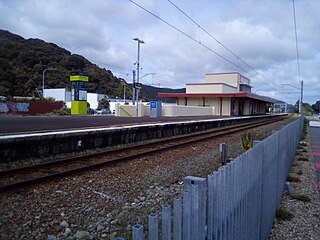
Taitā railway station is a suburban railway station serving Taitā in Lower Hutt, New Zealand. The station is located on the Hutt Valley section of the Wairarapa Line, 20.6 km (12.8 mi) north of Wellington. The station is served by Metlink's electric multiple unit trains of the "Matangi" FP class.

Melling railway station is the terminal station on the single track Melling Line in Lower Hutt, New Zealand. The single platform station serves the suburb of Melling. The station is served by Metlink's electric multiple unit trains.

Western Hutt railway station, formerly Lower Hutt, is an intermediate station on the single-track Melling Line in Lower Hutt, New Zealand, It is served by Metlink electric multiple unit trains operated by Transdev Wellington under the Metlink brand.




















